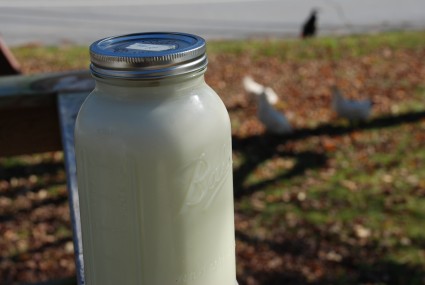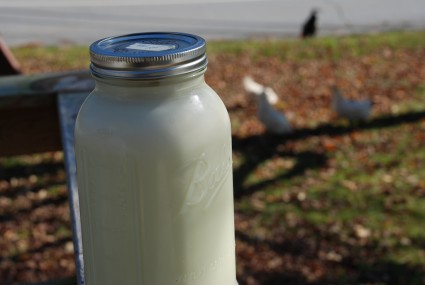 When the current phase of a nearly century-long government campaign to convince American consumers to abandon raw milk launched in 2006, heavy-handed intimidation tactics were the order of the day.
When the current phase of a nearly century-long government campaign to convince American consumers to abandon raw milk launched in 2006, heavy-handed intimidation tactics were the order of the day.
Kentucky farmer Gary Oakes was questioned so intensively by agents from the Ohio Department of Agriculture and U.S. Food and Drug Administration while delivering milk to consumers in a Cinciannati parking lot that spring that he was hospitalized three times for symptoms of post-traumatic stress disorder. Michigan farmer Richard Hebron had more than $8,000 of dairy products confiscated in a “sting” operation outside Ann Arbor on Columbus Day weekend of 2006; for five months afterwards, he was threatened with criminal prosecution that might have landed him in jail, before finally being let off with a small fine. And Mennonite farmer Mark Nolt endured three raids on his raw dairy — including confiscation of expensive milk and cheese-making equipment — by state police, FDA, and Pennsylvania Department of Agriculture agents during 2007 and 2008.
The fact that the heavy-handed intimidation operations against raw dairies have abated over the last couple years shouldn’t be mistaken for a letup in the federal and state campaign against raw milk, though. Rather, there has been a shift in tactics.
Those earlier assaults on owners of small farms generated enough unfavorable publicity that federal and state authorities have opted for a less distasteful approach. The emphasis now is on ever-closer regulatory oversight of raw milk sellers and distributors, as well as court actions.
A major target over the last year has been private buying groups. These groups of anywhere from a few dozen to hundreds of consumers have organized in states where raw milk either is banned for general sale, or else available only from dairy farms. They have grown out of the exploding popularity of raw milk and the resulting demand by consumers to be able to conveniently obtain raw milk without traveling hours to a farm. In many states, they have long been tolerated … until now.
In Georgia last October, state agriculture authorities confiscated more than 100 gallons of raw milk purchased by members of a buying group from farms in neighboring South Carolina, where raw milk can be legally sold. The group had been in operation for five years without any problem.
In November, Missouri’s attorney general sued a farm couple after their daughters sold raw milk to undercover public health investigators. The girls were distributing the milk to regular buyers from a health store parking lot, which is legal in Missouri. But when the girls apparently agreed to sell some extra milk to the undercover agents, they entered a gray area. Yet undercover agents and state attorney general involvement would seem a little extreme, if indeed there was a transgression.
Even liberal Massachusetts, which has for years tolerated buying groups delivering raw milk from farms in the central and western parts of the state to buyers in the Boston area and elsewhere, has gotten in on the act. It has sent cease-and-desist orders to three buying clubs in the last month, even though Massachusetts hasn’t had a single illness from raw milk in more than a decade.
The commissioner of Massachusetts’ Department of Agricultural Resources, Scott Soares, contends that it’s raw milk’s growing popularity that has made his people nervous, rather than any grand strategy to sabotage raw milk sales. “We’re seeing a lot more interest and growth in raw milk,” he says. “We recognize there’s a demand for raw milk.” His department supports raw milk sales by farms as a means of economic development, but says its main concern about the buying groups is that because they aren’t regulated, there is “a loss of control when milk leaves the farm and there are no guarantees the milk will be held at the proper temperature.”
Ground zero in the regulatory assault on raw milk is Wisconsin, which officially prohibits the sale of raw milk, but has similarly turned a blind eye to private buying groups of various sorts over the last decade. The agency blames ever-bolder raw milk producers and buying groups for upsetting the delicate balance that had existed. According to Donna Gilson, spokesperson for Wisconsin’s Department of Agriculture, Trade, and Consumer Protection. “Newspaper stories started popping up about farmers selling raw milk. Some of the stories said they had found a legal way to do it. There is not a legal way to do it. They were right in our face with it.”
Since then, at least seven dairy farms and buying groups have either received orders prohibiting their raw milk activities, or demanding detailed information about their activities, from Wisconsin’s DATCP, in anticipation of a stop order. Some dozens of other dairies have received warning letters.
“We’ve never seen anything as aggressive and coordinated as what’s happening in Wisconsin,” says Pete Kennedy, president of the Farm-to-Consumer Legal Defense Fund, which helps defend raw dairies under state and federal assault.
It’s hard not to conclude that these seemingly disparate efforts aren’t being coordinated, and indeed, there is evidence they have been. Last year, the head of one Wisconsin buying club, Max Kane, used the equivalent of a state freedom-of-information act request to obtain email exchanges between FDA, DATCP, and other public health and agriculture officials in the Midwest; the emails detailed plans to go after possibly twenty buying groups in Illinois. The plan, according to the emails, was to go after the buying groups one at a time, for maximum deterrent effect.
Increasingly, America’s public health establishment looks out on the food landscape and sees growing hordes of raw milk consumers. While no one knows for sure how many Americans are drinking raw milk — estimates range from 500,000 to as many as 10 million or more — we know the numbers are rising because more dairies and more buying groups are being established to handle production and distribution. Can the FDA and its state brethren disrupt supplies enough to discourage growing demand? The answer to that question isn’t yet certain, but what is clear is that the authorities are trying very hard.

